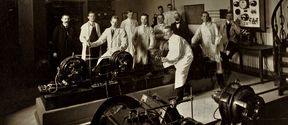This page is part of a series on the history of mechanical engineering in Finland. You will find links to the previous and next part in the series at the bottom of the page.
Profile: Axel Ahlfors
Appendix 2.1.
This page is part of a series on the history of mechanical engineering in Finland. You will find links to the previous and next part in the series at the bottom of the page.
Chemistry was the discipline that attracted the most doctoral candidates in the early years of doctoral education in the field of technology – of the first ten dissertations, five were completed by chemists. Those ten also included a dissertation from the field of surveying, Carolus Lindberg’s architectural work on the structural engineering of medieval stone churches, dated 1919, and Ossian Hannelius’s work on bridge construction from 1921.
The first doctorate of the Helsinki University of Technology was completed by Sulo Viljo Hintikka, whose work on the topic of organic chemistry, called Kamfelonitutkimuksia (Studies on Camphenilone), was accepted in March 1911 as dissertation number two.
The engineers' attempts at dissertations were not as successful, however, as nearly all of them were left unfinished. Dissertation number one, had it been completed, would have made its author Georg Fredrik Jansson the first doctor of technology. Jansson was accepted as a doctoral candidate on 21 October 1909.
Jansson’s main focus was electrical engineering. After completing his primary studies in Germany, he continued his education at the Technical University of Karlsruhe. After spending some time in Finland, he moved on to Vienna to attend its technical university. He returned to Helsinki in the fall of 1912, having been appointed to an assistant's position within the electrical engineering department. Later, he worked as a teacher of electrical engineering at the technical college in Tampere, and thus his dissertation was never completed.
Engineers Ossian Strömmer and Maximilian Sergelius applied for permits to complete dissertations in 1912 and in 1913, respectively. Both worked for some time as assistants at the mechanical engineering department. As with Jansson, however, neither would complete their dissertation. Strömmer later worked as teacher at a vocational school and published several texts in his area of expertise. Sergelius worked at Helsinki’s industrial school as lecturer between 1912 and 1925 and as the school's headmaster between 1914 and 1922. He was also a teacher at the technical institute of Helsinki from 1916 to 1954 as well as its rector from 1916 to 1954. Sergelius joined the Parliament of Finland in 1926, representing the Swedish Left party.
Toivo Wilho Salonen published his work on metal chip detachment in 1917 as dissertation number 10. However, the work was heavily criticised, and Salonen never completed the other parts of the degree. In 1922, he applied for the position of professor in the field of general mechanical engineering and industrial economics. Though he was considered qualified, Bernhard Vuolle was eventually chosen for the position. Salonen then worked at the technical college in Tampere as a teacher between 1922 and 1926, after which he moved on to lead a private engineering company.
The first candidate in the field of mechanical engineering to complete their dissertation was Jarl Kuusinen (from 1940 onward known as Jarl Salin), who had completed diploma theses in both mechanical and electrical engineering. His doctoral dissertation, Wahrscheinlichkeitsberechnungen in der Kraft- und Wärmetechnik, was accepted as dissertation number 18 in 1936. Salin worked during the 1920s at Åbo Akademi as a professor of mechanical engineering and was in charge of the construction of the Imatra hydroelectric power station between 1927 and 1929.
The next doctorates in the mechanical engineering department were completed by Reino Castrén and Arvo Ylinen, with dissertations on production economy and aircraft manufacturing, respectively.
The degree regulations were reformed in 1971. After the reform, the department collegium would accept or reject dissertations after the public defence was over. Once the degree was approved, the candidate received a diploma signed by the rector and the head of the department. Completing the degree conferred the doctoral title.
At HUT, the problem of the doctoral degree and title was solved with the degree regulations of 1979, which simply stated that the diploma confirming the doctoral degree would also confer the title of doctor. The doctoral promotion, the organising of which was the responsibility of the administrative collegium, would thus only serve the purpose of conferring the doctoral insignia. Upon request, the collegium could grant the rights to the doctoral insignia without the ceremonial promotion.
The issue of "non-promoted" doctorates was ultimately resolved in 1987, after which all graduating doctoral students have been promoted, whether they are present or absent for the event.
Appendix 2.1.

In Finland, the origins of technology education trace back to the 1840s.